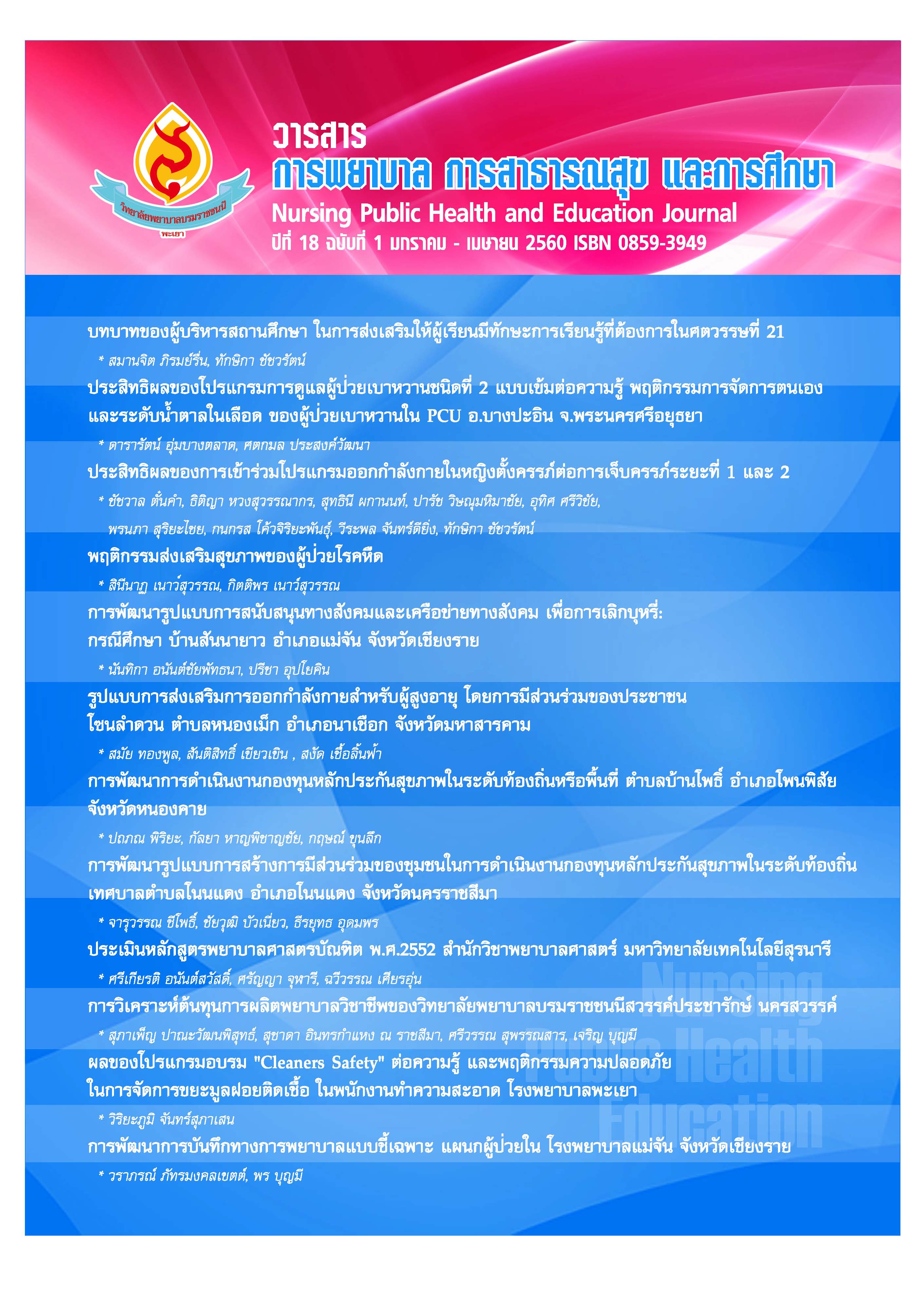การพัฒนารูปแบบการสนับสนุนทางสังคมและเครือข่ายทางสังคม เพื่อการเลิกบุหรี่: กรณีศึกษา บ้านสันนายาว อำเภอแม่จัน จังหวัดเชียงราย
Keywords:
การพัฒนารูปแบบ, การสนับสนุนทางสังคม, เครือข่ายทางสังคม, การเลิกบุหรี่, Development of Model, Social Support, Social Network, Abolition of SmokingAbstract
การวิจัยเชิงปฏิบัติการนี้ มีวัตถุประสงค์เพื่อพัฒนารูปแบบการสนับสนุนทางสังคมและเครือข่าย ทางสังคม สำหรับการเลิกสูบบุหรี่ กลุ่มตัวอย่างคือผู้สูบบุหรี่บ้านสันนายาว อำเภอแม่จัน จังหวัดเชียงราย จำนวน 42 คน มีขั้นตอนการดำเนินงาน 3 ระยะ คือ ระยะที่ 1 ขั้นตอนการสร้างความสัมพันธ์กับชุมชนและผู้สูบบุหรี่ และสำรวจข้อมูลที่เกี่ยวข้องกับการสูบบุหรี่ของชุมชน ระยะที่ 2 ขั้นตอนการให้ความรู้และเสริมสร้างกำลังใจให้กับเครือข่ายทางสังคมในชุมชนและผู้สูบบุหรี่ และระยะที่ 3 ขั้นตอนการประเมินและวัดผลการเปลี่ยนแปลง
ผลการศึกษาได้รูปแบบการเลิกสูบบุหรี่ที่มีชื่อเรียกว่า “CASE SALE Model” โดยองค์ประกอบของรูปแบบ มี 2 ส่วน คือ (1) ปัจจัยภายนอกและ (2) ปัจจัยภายใน ซึ่งปัจจัยภายนอกได้แก่ความร่วมมือกันของเครือข่ายทางสังคม ได้แก่ ครอบครัวอาสาสมัครสาธารณสุขประจำหมู่บ้าน เจ้าหน้าที่โรงพยาบาลส่งเสริมสุขภาพตำบล พระสงฆ์ และผู้วิจัย ที่ได้ร่วมมือกันในการให้คำปรึกษา (Consult : C) ให้คำแนะนำ (Advice : A) ให้การช่วยเหลือสนับสนุน (Support : S) ตลอดจนส่งเสริมให้กำลังใจ (Encouragement : E) เพื่อให้ผู้สูบบุหรี่เลิกสูบได้สำเร็จสำหรับปัจจัยภายในที่มาจากตัวผู้สูบบุหรี่เอง ได้แก่ ความ มีคุณค่าในตนเอง (Self Esteem : S) การยอมรับ(Acceptance : A) ความรักตัวเองและคนรอบข้าง (Love : L) และความประหยัด (Economy : E) ผลการใช้รูปแบบทำให้มีผู้เลิกสูบบุหรี่ได้สำเร็จจำนวน 14 คน ลดจำนวนการ สูบบุหรี่ลงจำนวน 24 คน สูบบุหรี่จำนวนเท่าเดิม 4 คน
Development of Social Support and Social Network Model
for the Abolition of Smoking: a case study of Bann Sannayao Village, Maechan District, Chiang Rai Province
The purpose of this action research was to develop social support and social network model for the abolition of smoking. The samples were 42 smokers of Bann Sannayao Village, Maechan District, Chiang Rai Province. There were three phases of operation. The first step was to build relationships with the community and smokers, and explore information relating to smoking of the community. The second step was providing education and motivation for social networks in the community and smokers, and the final step was to evaluate the process and measure changes.
The result of the study was the model of the abolition of smoking called "CASE SALE Model". The model consisted of two parts. The first part was the external factors and the second part was the internal factors. The external factors were collaborations of social networks which included families, public village health volunteers, health promoting hospital staff, Buddhist monks, and researcher. The collaborative activities concerning: counseling (C), advising (A), supporting (S) and encouraging (E). The collaborations were to assist the smokers to quit smoking successfully. The other part was the internal factors of smokers which involved self-esteem (S),acceptance (A),loving themselves and people around them (L)and economy (E). The implementation of the model resulted in 14 smokers stopped smoking, 24 smokers reduced their smoking, and four smokers still keep smoking.


